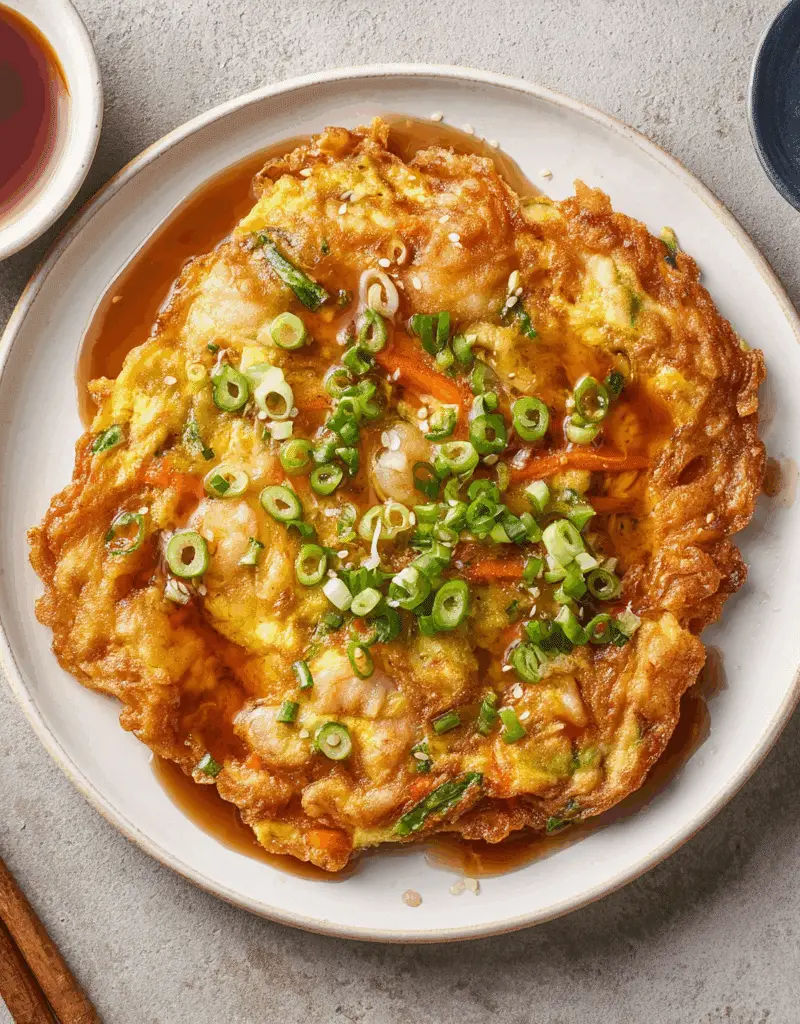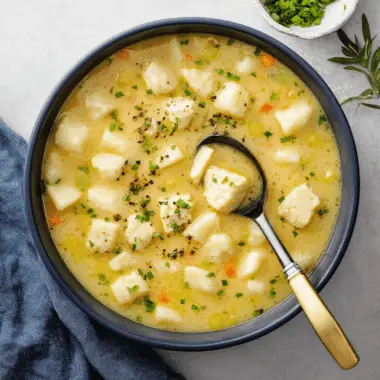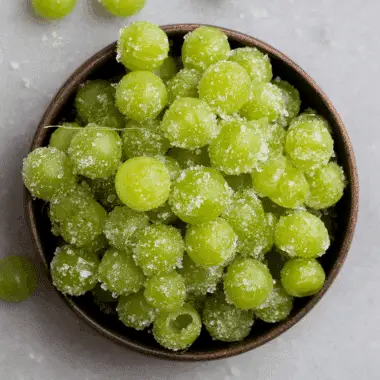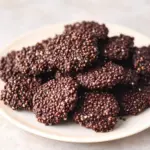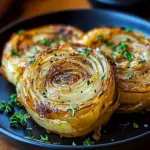The Chinese-American classic Egg Foo Young is a delightfully crispy omelette packed with fresh vegetables and optionally filled with shrimp or chicken. It’s pan-fried to golden perfection and traditionally served with a rich brown gravy that ties it all together.
Quick to prepare and deeply satisfying, this dish is perfect for weeknight dinners or a weekend brunch with an Asian twist. Whether you’re familiar with it from Chinese takeout or trying it for the first time, Egg Foo Young brings together nostalgic flavors with home-cooked comfort. Serve it hot with a drizzle of gravy and a side of steamed rice for a complete meal that’s both simple and memorable.
Full Recipe
Ingredients:
-
4 large eggs
-
1/2 cup bean sprouts
-
1/4 cup green onions, finely chopped
-
1/4 cup shredded carrots
-
1/4 cup diced cooked shrimp or chicken (optional)
-
1 tablespoon soy sauce
-
1 teaspoon sesame oil
-
1/4 teaspoon white pepper
-
2 tablespoons vegetable oil (for frying)
Gravy:
-
1 cup chicken broth
-
1 tablespoon soy sauce
-
1 tablespoon oyster sauce
-
1 teaspoon cornstarch mixed with 2 tablespoons water
Directions:
-
In a large bowl, beat the eggs.
-
Stir in bean sprouts, green onions, carrots, and cooked shrimp or chicken (if using). Add soy sauce, sesame oil, and white pepper. Mix well.
-
Heat 1 tablespoon of vegetable oil in a skillet over medium heat. Pour 1/4 of the egg mixture into the skillet to form a small pancake. Cook until the edges are golden brown and the center is set, about 2–3 minutes per side. Repeat with remaining egg mixture, adding oil as needed.
-
In a small saucepan, combine chicken broth, soy sauce, and oyster sauce. Bring to a simmer. Add the cornstarch slurry and stir until the gravy thickens.
-
Serve the omelettes warm with the savory gravy drizzled on top.
Prep Time: 10 minutes | Cooking Time: 15 minutes | Total Time: 25 minutes
Kcal: 215 kcal | Servings: 4 servings
What Is Egg Foo Young?
Egg Foo Young is a Chinese-style omelette that has become a beloved staple of Chinese-American cuisine. Originating from Cantonese cooking traditions, this dish typically consists of beaten eggs mixed with vegetables such as bean sprouts, onions, and sometimes meat or seafood like shrimp, pork, or chicken. It’s then pan-fried until golden brown and often served with a savory brown gravy poured over the top. The texture is crispy on the outside while remaining tender and fluffy on the inside. It’s fast, flavorful, and flexible—qualities that have made it a favorite in both restaurants and home kitchens around the world.
The Origins and Cultural Evolution
Egg Foo Young’s roots trace back to traditional Chinese egg dishes, particularly those found in Cantonese cuisine. In Chinese cooking, egg dishes symbolize prosperity and good fortune. When Chinese immigrants settled in North America during the 19th and early 20th centuries, they adapted their culinary heritage to suit Western palates and ingredients. Egg Foo Young was born from this blending of cultures—a Chinese omelette adjusted for American tastes, combining familiar textures and flavors in a new form. Over time, it evolved into a restaurant classic, often included on menus at Chinese-American diners and takeout joints. Though you may find variations across different regions, the essence of Egg Foo Young remains constant: it’s comforting, protein-rich, and deeply satisfying.
A Dish That Celebrates Versatility
One of Egg Foo Young’s greatest strengths is its adaptability. It can be made vegetarian with just vegetables, or enriched with proteins like chicken, beef, shrimp, or even tofu. The veggies used can vary widely—bean sprouts, shredded carrots, bell peppers, scallions, mushrooms, cabbage—all work well. This makes it ideal for using up leftovers or tailoring to dietary preferences. Whether you’re cooking for meat-eaters or vegetarians, there’s a version of Egg Foo Young to suit your needs. Additionally, the dish is naturally low in carbs and high in protein, which also makes it appealing for those following keto or low-carb diets.
Gravy: The Secret to Elevating Egg Foo Young
What sets Egg Foo Young apart from typical omelettes is the addition of the thick, savory brown gravy poured on top. This sauce often includes soy sauce, oyster sauce, chicken broth, and a cornstarch slurry to thicken it. It provides a rich, umami-packed layer that complements the crispy egg exterior. In Chinese-American cuisine, sauces are not merely condiments; they serve to unify the dish. The gravy for Egg Foo Young transforms a simple egg dish into something deeply comforting and crave-worthy. It’s rich, glossy, and often flavored with garlic or ginger for added depth.
Perfect for Weeknight Dinners or Meal Prep
Egg Foo Young is not just delicious—it’s practical. It comes together in about 20–30 minutes, making it perfect for busy weeknights. Since the omelettes are small and pan-fried individually, they’re easy to portion out and reheat. You can cook a batch in advance and store them in the fridge for up to four days. The gravy can also be made ahead and gently reheated when ready to serve. It’s a great meal-prep dish that doesn’t sacrifice flavor for convenience. Pair it with steamed rice, cauliflower rice, or stir-fried vegetables for a complete and balanced meal.
Regional Variations Around the World
While Egg Foo Young is well-known in the United States and Canada, variations of the dish exist worldwide. In Indonesia and the Netherlands, it’s known as “Fu Yung Hai” and is typically served with a sweet-and-sour tomato-based sauce instead of brown gravy. In parts of Southeast Asia, chili paste and fish sauce might be added for extra heat and funk. The American-Chinese version leans toward a thicker, brown gravy and a heartier mix of fillings, while other countries emphasize different ingredients or sauces. This speaks to the global reach and culinary flexibility of the dish—it’s been adopted, adapted, and reinvented across cultures.
Why Egg Foo Young Deserves More Attention
Despite its status as a takeout classic, Egg Foo Young often flies under the radar compared to other Chinese-American dishes like General Tso’s Chicken or Kung Pao Shrimp. That’s unfortunate, because it offers a unique combination of flavor, texture, and nutrition. It’s also a testament to the power of culinary fusion—how immigrant communities shaped national food identities while staying connected to their heritage. In an age where many are turning to nostalgic comfort foods and easy home-cooked meals, Egg Foo Young is experiencing a quiet resurgence. It’s uncomplicated, delicious, and endlessly customizable.
Tips for the Best Homemade Egg Foo Young
While the recipe is straightforward, there are a few tricks that elevate it from good to great. First, make sure to beat the eggs thoroughly to incorporate air, which helps create a fluffier texture. Use a nonstick skillet and preheat it well before frying to get that golden-brown crispness. Don’t overcrowd the pan—cook one or two omelettes at a time for even browning. For a deeper flavor, you can add a touch of sesame oil to the egg mixture. And don’t forget the gravy: a well-seasoned sauce is the soul of this dish, and freshly made gravy makes a big difference.
A Dish for All Ages and Occasions
Egg Foo Young appeals to people of all ages. Kids often love the crispy texture and mild flavors, while adults appreciate the satisfying protein content and savory gravy. It can be served as a main course or a side dish, and works well for brunch, lunch, or dinner. Because of its adaptable nature, it’s also a great dish for entertaining guests with varying dietary needs. Whether it’s a casual family meal or part of a larger spread, Egg Foo Young delivers every time.
Conclusion: Rediscovering a Classic
Egg Foo Young may not always get the spotlight, but it’s a dish worthy of admiration. It’s quick, versatile, deeply flavorful, and steeped in culinary history. Whether you remember it from your childhood takeout nights or are trying it for the first time, it’s bound to surprise you with just how satisfying it is. In a time when more people are cooking at home and seeking comfort in food, Egg Foo Young offers a perfect mix of tradition and practicality. Give it a try—you just might find it becomes a new favorite in your kitchen.

